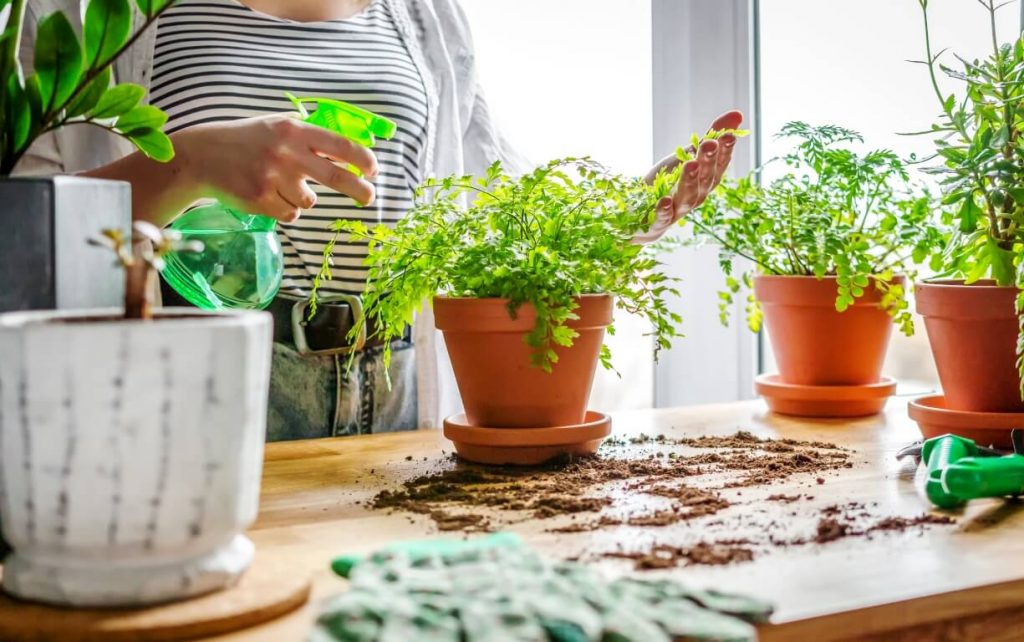The Easter lily, scientifically known as Lilium longiflorum, was originally indigenous to Taiwan and three small Japanese islands. However, it has been distributed worldwide for a considerable period. In its natural habitat, this plant typically reaches a maximum height of 3 inches. But, those grown in greenhouses and subjected to hormone treatments may be shorter. Easter lilies are characterized by their oval, dark green, glossy leaves, and sturdy, cylindrical stems with a 5 cm diameter, bearing 12-15 flowers each, ranging from 3 to 7 inches in size. When cultivated in cooler conditions, these plants tend to produce more leaves.
Easter lily is highly regarded for its graceful and fragrant white flowers that take on a trumpet-like shape, with petals gently curving outwards. These blossoms showcase a delicate charm with their slightly upturned petals, revealing hints of pale green at their tips and deep yellow anthers. In some cases, these flowers may even display shades of pink, cream, or orange among their six petals arranged in two layers.
If you are interested in this topic, you can also read
<<How To Grow Catnip Indoors >> and <<Exacum Affine Care>> articles.
Lilium Longiflorum (Easter lily) Overview
| Family | Liliaceae |
| Origin | Taiwan and Japan |
| Names | American white, Trumpet lily, November Lily, Christmas Lily, Bermuda lily |
| Genus | Lilium |
| species | L.langiflorum |
| More species from the Gentianaceae family | Asiatic lily, Martagon lily, Orienpet lily, Oriental lily, Tiger lily |
| Dimensions | Height of about 6 to 18 inches, spread ranging from 6 to 12 inches |
| Toxicity | Poisonous to cats |
| Life cycle | Annual |
| USDA Hardiness Zones | 5-8 |
| Bloom time | Spring |
| Foliage | Evergreen |
| Propagation method | Seeds, scaling, bulb division |
| Sun exposure | Full sun and part shed |
| Soil type | Moist, well-drained and Slightly acidic (6 to 7 pH) |
| Flower colors | White and yellow |
| Decorative Life | 4-11 days |
Religious Symbolism & Meaning
The period from April to June allows one to bask in the abundant beauty of the Easter lily. Given its irregular flowering schedule, it is often employed symbolically during occasions such as Easter, representing the resurrection of Christ, or at weddings, where it symbolizes hope, purity, and innocence. In ancient Greece, the lily held the esteemed position of being the favored flower of Hera, the goddess associated with the moon, earth, air, women’s lives, marriage, and childbirth. Similarly, in ancient Rome, it served as a symbol of Juno, the goddess linked to light, the sky, marriage, and motherhood [1, 2].
Easter Lily Uses And Applications
Bees and butterflies around your garden will thank you as the Easter lily is one of their beloved plants. So, by incorporating Easter lilies in your garden, you will support local pollinators too. It is interesting to note that they are used in the production of perfume and cosmetics due to their sweet fragrance. It is also worth mentioning that bulbs are edible and have shown some medical uses. These bulbs have been utilized in the treatment of conditions like coughs, hemoptysis (coughing up blood), insomnia, and restlessness during the later stages of febrile diseases [3].
How To Grow Easter Lily
Growing and maintaining Easter lilies is remarkably straightforward, making them suitable for various environments, whether a garden bed or a container. This ease of cultivation contributes to their popularity as a choice for cut flowers in floral arrangements and bouquets.
For optimal results, it’s advisable to plant them in the spring, ideally in groups of at least three bulbs, which promotes robust root development. Alternatively, planting them in the fall can also yield success, allowing the lilies to bloom in early spring. Before planting, ensure that you’ve enriched the soil with compost and loosened it to a depth of 12-15 inches. Deep planting is crucial as it provides stability to your lilies.
As a general guideline, bulbs should be planted at a depth three times their own height. Digging holes in a zigzag pattern aids in better air circulation and reduces the risk of disease. Afterward, gently fill the soil and water the area to settle the bulbs. Keep in mind that it’s advisable to plant Easter lilies in a location protected from strong winds to prevent their tall stems from easily breaking.
Easter Lily Care
Light
Easter Lilies thrive when they receive a combination of full sunlight and partial shade. Ideally, they should have access to 6 to 8 hours of sunlight daily while benefiting from what’s known as ‘cold feet,’ which means that the lower part of the plant should be shaded. This shading not only helps maintain soil moisture but also protects from the intense late afternoon sun, which can be beneficial for the health of the plant.
Soil
To showcase their beauty in your garden, Easter lilies require soil that is consistently moist, enriched with organic material, and well-drained. You can enhance the soil by incorporating a layer of mulch, such as shredded leaves, which serves to retain moisture, regulate soil temperature, and suppress weed growth. Ideally, the soil should have a slightly acidic to neutral pH, although Easter lilies can also tolerate a slightly alkaline pH if necessary.
Water
Do not plant Easter lilies in spots prone to flood or overwatering that might lead to root rot. Just keep the soil moist, not soggy. Once or twice a week is enough, depending on the weather and climate.
Blooming Time
Easter lilies typically bloom in early to mid-summer. To encourage more flowering, it’s essential to remove the spent leaves and blossoms. These flowers have a lifespan of a few weeks. Therefore, if you plan to buy a lily in full bloom, it’s a good idea to select a plant with just one or two open flowers and several closed buds on the stem, along with healthy green foliage. Since each flower only remains vibrant for a few days, having more unopened buds ensures a longer duration of enjoyment indoors.
Temperature And Humidity
Ensuring the success of your Easter lily when transplanting it outdoors starts with providing excellent care while it’s still flowering indoors. This involves positioning it near a window that receives ample bright light but avoids direct sunlight. Maintaining a cool indoor temperature within the range of 65 to 75°F is ideal for the growth of Lilium longiflorum plants.
To extend the blooming period of your longiflorum lily, steer clear of placing it in overly warm locations, such as near heating vents or radiators. Regarding outdoor planting, Lilium longiflorum is cold-hardy in USDA zones 5-8, and some varieties can even grow in zone 4 with the appropriate winter protection measures.
Fertilizer
Throughout the growing season, it’s advisable to use slow-release organic fertilizer to ensure robust growth and prolific flower production in your lilies. It’s important to steer clear of high-nitrogen fertilizers, as these can promote excessive foliage growth at the expense of flowering. A good practice is to apply the fertilizer during the early stages of growth and then again after the flowering period to support the overall health and vitality of the plants.
Common issue
When you water the plant, be sure to direct the water at the base of the stem to prevent fungal diseases. If you have particularly tall lilies, they will appreciate your efforts to support them because the weight of their blossoms can sometimes be too much for their stems to bear. Easter Lilies are vulnerable to a mosaic virus that is transmitted by aphids, making regular pesticide application a wise choice as there is no cure once the infection takes hold. Additionally, you can use a mixture of dish soap and water to spray and remove aphids from the plants [4].
Another important aspect to keep in mind is to be vigilant for snails and slugs, which can damage your Easter lilies. If you notice the leaves turning black, it’s an indicator that the plant might benefit from relocation to a warmer environment. On the other hand, if the leaves turn yellow, it’s a sign of overwatering. If the leaves turn brown, it suggests that they may have been exposed to sunburn. Monitoring these signs can help you ensure the health and well-being of your Easter lilies [5].
Propagating
There are three common methods for propagating lilies: scaling, bulb division, and seed germination, each with its own advantages and drawbacks. Among these methods, scaling is the most popular because it yields quicker results. To propagate through scaling, you simply remove small segments from the parent bulbs, transplant them into new pots, and encourage their growth.
Additionally, your lilies can produce some tiny offsets or bulblets around the mother bulb if you’ve taken care of them carefully. Once these bulbs have fully formed, you can pot them in another container with moist, well-drained soil. For those with patience, growing lilies from seeds is another option. While it takes approximately 2 years for them to reach full maturity, this method allows for greater diversity, often resulting in stronger and healthier lilies [6].
Pruning Lilium longiflorum during the middle of the growing season is a good practice. It involves deadheading spent blooms and trimming back any brown foliage. When cutting the stalks, it’s best to do so close to the base of the plant, as this encourages the redirection of the plant’s energy towards producing more flowers. With some luck, this process may even result in a second round of blooms, extending the flowering period.











